Contents
Under favorable conditions, a gooseberry bush can bear fruit for decades, but if it is planted in an unfortunate place, for example, in swampy soil or in the shade, then the plant is likely to get sick often. However, diseases are not the only difficulty in growing a crop. No less often, the plant is attacked by pests (insects, caterpillars), which not only spoil the crop, but can also lead to the death of the bush. Only timely treatment with special preparations, as well as preventive measures, can save gooseberries from these misfortunes.
When to work
As you know, the disease is easier to prevent than to cure, therefore, first of all, attention should be paid to preventive measures. If the treatment of gooseberries is carried out as needed – when the plants become ill or attacked by pests, then preventive procedures should be carried out in spring and autumn, as well as before and after flowering.
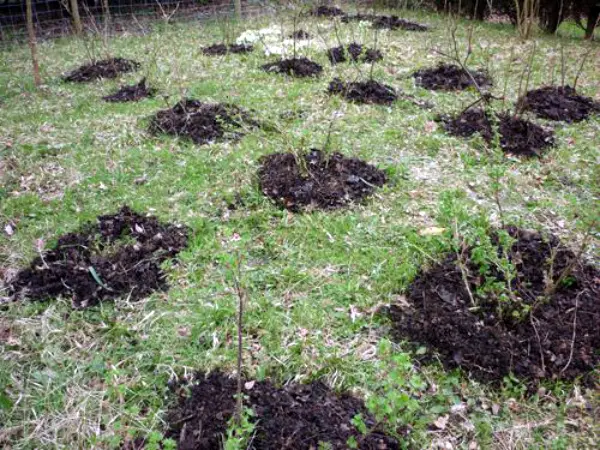
In early spring, while the buds have not yet blossomed on the gooseberries, the soil within the radius of the bush should be treated with disinfecting solutions: ash (2 kg / 10 l of water), copper sulfate (15 g / 5–7 l of water), baking soda and soap (50 g of soap , 2 tablespoons of soda / 10 liters of water).
Many gardeners in the spring use a remedy that has been proven by the people, which awakens the gooseberry and relieves it of pests and some diseases throughout the season – this is ordinary boiling water, cooled to 90-80 ° C. It is poured into a watering can and quickly, until the water has cooled, water the soil around the bush. This treatment helps to get rid of pest larvae and fungal spores that hibernate in the ground.
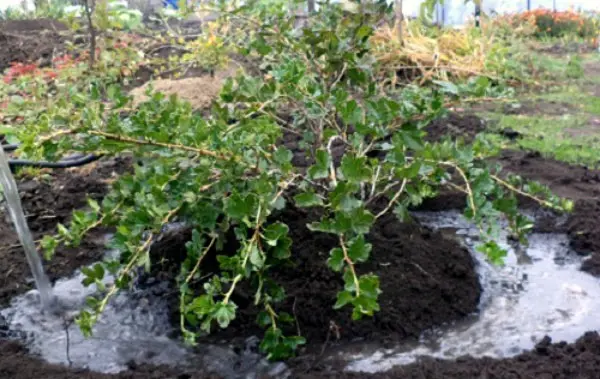
After watering, they collect all the fallen leaves, on which bacteria and larvae also live, and burn it. The ground under the bush is covered with pieces of film or roofing material so that the larvae and caterpillars cannot crawl out of their nests. Shelter is removed after flowering, when the caterpillars turn into butterflies and will not pose such a danger.
Also, preventive treatment for diseases is carried out in early spring. As soon as the gooseberries begin to bud, the bushes should be treated with Bordeaux liquid or fungicides. In the future, preventive spraying with the same Bordeaux mixture or a solution of soap and soda is carried out before the flowering of the bush, and then after it. These procedures allow you to protect the plant from powdery mildew (mold) and a number of other diseases.
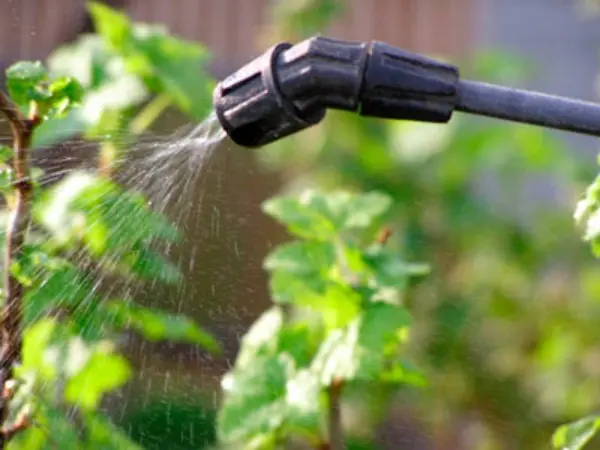
From pests (aphids, caterpillars), gooseberries are sprayed in spring with Karbofos (70 g / 10 l of water), Rovikurt or Actellik. This procedure is carried out at the stage of bud formation (before flowering).
In autumn, plants are not as much of a hassle as in spring. All that needs to be done before wintering is to cut branches, collect and burn fallen leaves, loosen the aisles and plentifully treat the soil with Nitrofen, a complex preparation for protecting horticultural crops from diseases and pests.
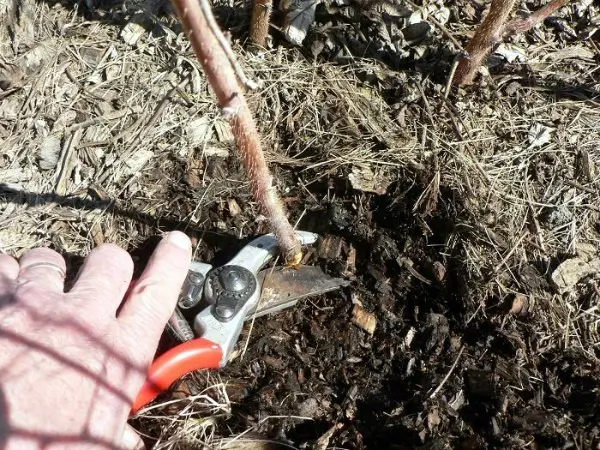
Safety Precautions
Preparations for the treatment of plants from pests and diseases (insecticides, fungicides) contain chemicals dangerous to humans, therefore, when using them, certain safety measures must be observed:
- Before processing gooseberries, you need to take care of protective equipment and clothing: overalls or a bathrobe, a scarf, rubber gloves, a respirator or a gauze bandage.
- Be sure to ensure that the drug or its vapors do not get on the skin, mucous membranes, eyes, respiratory organs.
- The preparation of working solutions should be carried out in the open air, in extreme cases, in a room with an exhaust hood or with an open window.
- Prepare the composition should be in protective clothing.
- To dilute the preparations, it is necessary to allocate dishes that are not used anywhere else, especially in cooking.
- Never mix different drugs, despite the fact that both have the same principle of action – their components can react with each other.
- Always read the instructions and never exceed the recommended concentration.
- It is necessary to prepare the solution in the amount required for one spraying. Diluted insecticides/fungicides should not be stored for a long time.
- When working with such strong preparations as Chlorophos, Karbofos, it is necessary to interrupt every half hour and breathe fresh air.
- Clothing used for work, as well as the room where the solutions were diluted, should be well ventilated, things should be left outside until the smell finally disappears.
- At the end of the work, you need to thoroughly wash your hands with soap and water, and best of all, take a shower.
- Store drugs should be in a dry, frost-free place that is inaccessible to children. Do not store chemicals in plastic containers (bottles), and do not pour excess solution down the sink, especially in the kitchen.
- When using insecticides, take care of the safety of pets. Spray gooseberries in the garden in the evening, when bees do not fly, as some substances, for example, Karbofos, are detrimental to them.
Video “Protection of gooseberries from caterpillars”
Gooseberry moth is the worst enemy of gooseberries. How to protect the shrub from the pest, this video will tell.
Fighting diseases and pests
If it was still not possible to protect the gooseberry from pests, then measures will have to be taken, and urgent ones. Most often, insects settle on the berry bush, which will be described below.
The gooseberry sawfly is not as dangerous to the plant itself as its larvae – light green caterpillars that eat leaves, leaving only veins. The mass invasion of these caterpillars often leads to the fact that the bush is left without leaves, because of which it begins to dry out over time, and the berries fall off. Pest control should begin in the fall: dig deep into the soil, remove insect cocoons if possible, and in spring, as caterpillars appear, spray bushes with Spark or wormwood infusion.
Gooseberry moth – butterflies that settle on the culture during the appearance of buds and lay eggs inside the flowers. By the time the ovary is formed, greenish caterpillars with a black head appear from the eggs, which crawl into the berries and devour them from the inside. In summer, you can get rid of caterpillars only by removing damaged berries. In autumn, the ground around the bushes is dug up and abundantly watered with insecticides or folk remedies (wormwood decoction, tobacco infusion).

Aphids are tiny insects that are not immediately noticeable, but are usually found when a whole colony has already multiplied. Both adults and larvae feed on the juice of young shoots and leaves, causing great damage to the plant. Leaves damaged by aphids curl, and shoots slow down their growth. If it was possible to detect insects as soon as they appeared, then it is enough to spray the gooseberries with a soapy solution (300 g of soap / 10 l of water). If the colonies have managed to multiply, insecticides are applied.
Currant glass is an equally dangerous enemy of gooseberries. Caterpillars of this butterfly can be distinguished by a brownish, sometimes light yellow color. The insect lays eggs on the gooseberry towards the end of its flowering, and after a few days caterpillars appear from them, which make moves in the core of the branches. Multiple settlements of glass caterpillars lead to the drying of the bush. To get rid of insects, as well as their caterpillars, the bushes are sprayed with Karbofos, in the fall the soil is watered with insecticides.
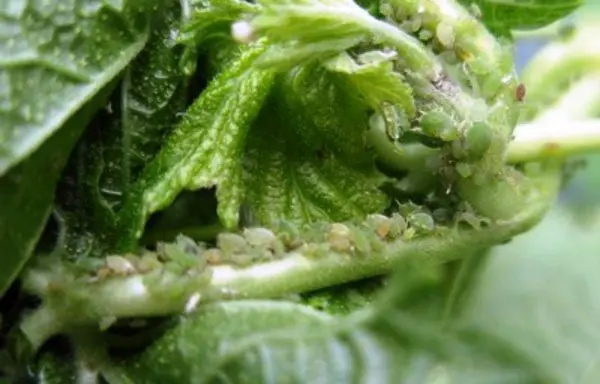
Gooseberry moth is another type of caterpillar that often appears on gooseberries. The moth lays its eggs under the bark or under the leaves, and its caterpillars also hatch there. These large (4–5 cm) caterpillars are distinguished by their multi-colored color and high ability to damage not only leaves, but also shoots. You can destroy moth caterpillars with the same preparations that are used for glass and sawfly caterpillars.
Unfortunately, a variety of caterpillars and insects are not the only threat to gooseberries. Despite the fact that the culture is resistant to many diseases, powdery mildew in its various manifestations most often affects it. At the initial stage, the disease is characterized by a loose mealy coating, which becomes denser and darker over time. As a rule, the defeat begins with berries, and then with the help of wind and insects, this white pollen spreads to leaves and shoots. If you do not take action, then soon the leaves are deformed, turn yellow, and then fall off, the berries crack and dry out. This situation leads not only to the loss of the crop, but also to the gradual death of the bush.
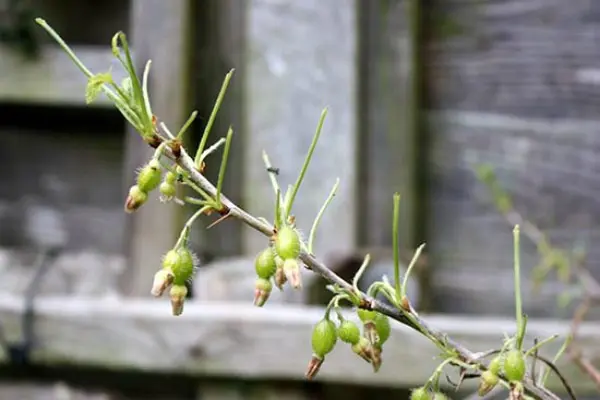
To combat powdery mildew on gooseberries, spraying is used. If the disease is detected in the spring, even before the leaves and buds appear, then fungicides (Nitrofen, blue vitriol) can be safely used. If the plaque on the bushes appeared during the flowering period, the formation of the ovary, or even later, then spraying is carried out with a solution of soap and soda ash. To prevent the disease, the soil around the bushes is dug up and watered with fungicides in the fall, after the foliage has fallen.
At first glance, it may seem that caring for gooseberries is very troublesome. But that’s only if he’s sick.
To keep the bushes healthy and fruit well, plant them in a sunny area with well-drained soil – the good location of the plants solves many problems and increases yields.
Video “Processing gooseberries from pests”
There are many pests on gooseberry bushes in early spring. How to deal with them, watch the video.









